Published on
She taught her cockatoo to read.
That was just the beginning
Northeastern University researcher Jen Cunha helped unlock new discoveries about what parrots — among the most intelligent animals in captivity — are capable of. Her 11-year-old Goffin’s cockatoo can read basic words, draw 14 letters on a touchpad with her beak, and communicate a wide array of complex feelings and requests on her tablet.
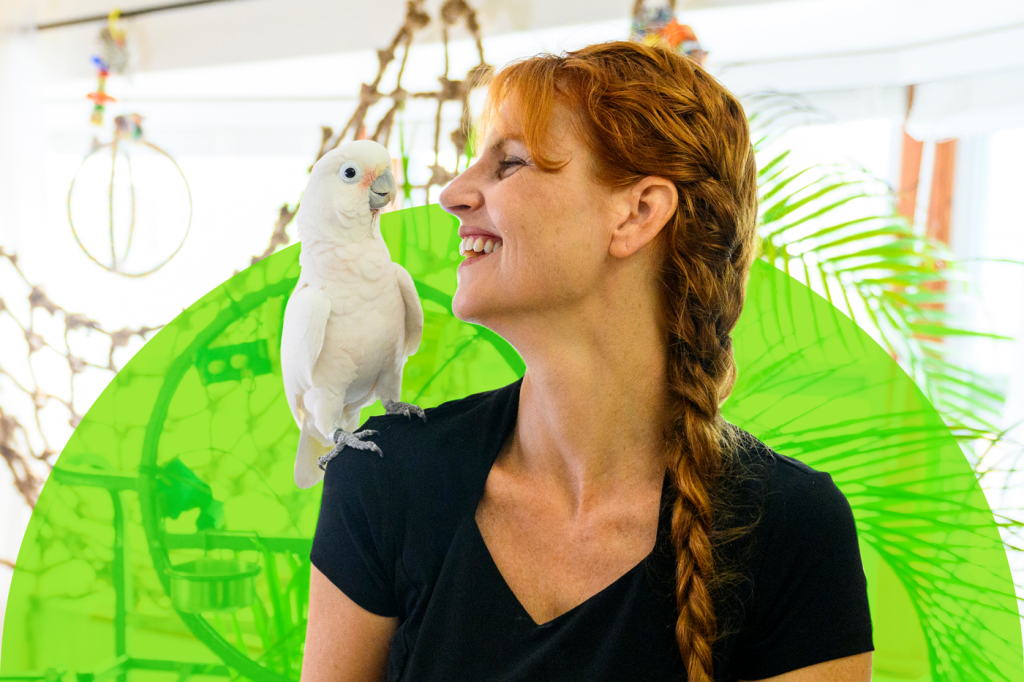
The squirrel is playing a tablet game.
This is the first tech-savvy critter Jen Cunha introduces at her home in Jupiter, Florida, on a sun-soaked morning in early March. An affiliated researcher with Northeastern University, Cunha began training two squirrels, dubbed “Noel” and “Holly,” to use a tablet when Noel wandered into her kitchen’s open door last year—mangy, sick and clearly hungry.
After getting them healthy, “I said, ‘Listen, ladies, I’ll feed you, but you’re going to work for it,’” she recalls. She dabs peanut butter on the screen of a Samsung Galaxy device outfitted with a foam purple case, worn with scratches and bite marks, and sets it down on her back deck. Soon, Holly scampers up, selects from the menu of options, and settles into a game of “Balloon Pop”—familiar to anyone who knows a preschooler. She uses her nose to jab the multi-colored balloons that float onto the screen, making satisfying “Bop!” sounds as they burst.
But Holly, incredibly, is not the main attraction.
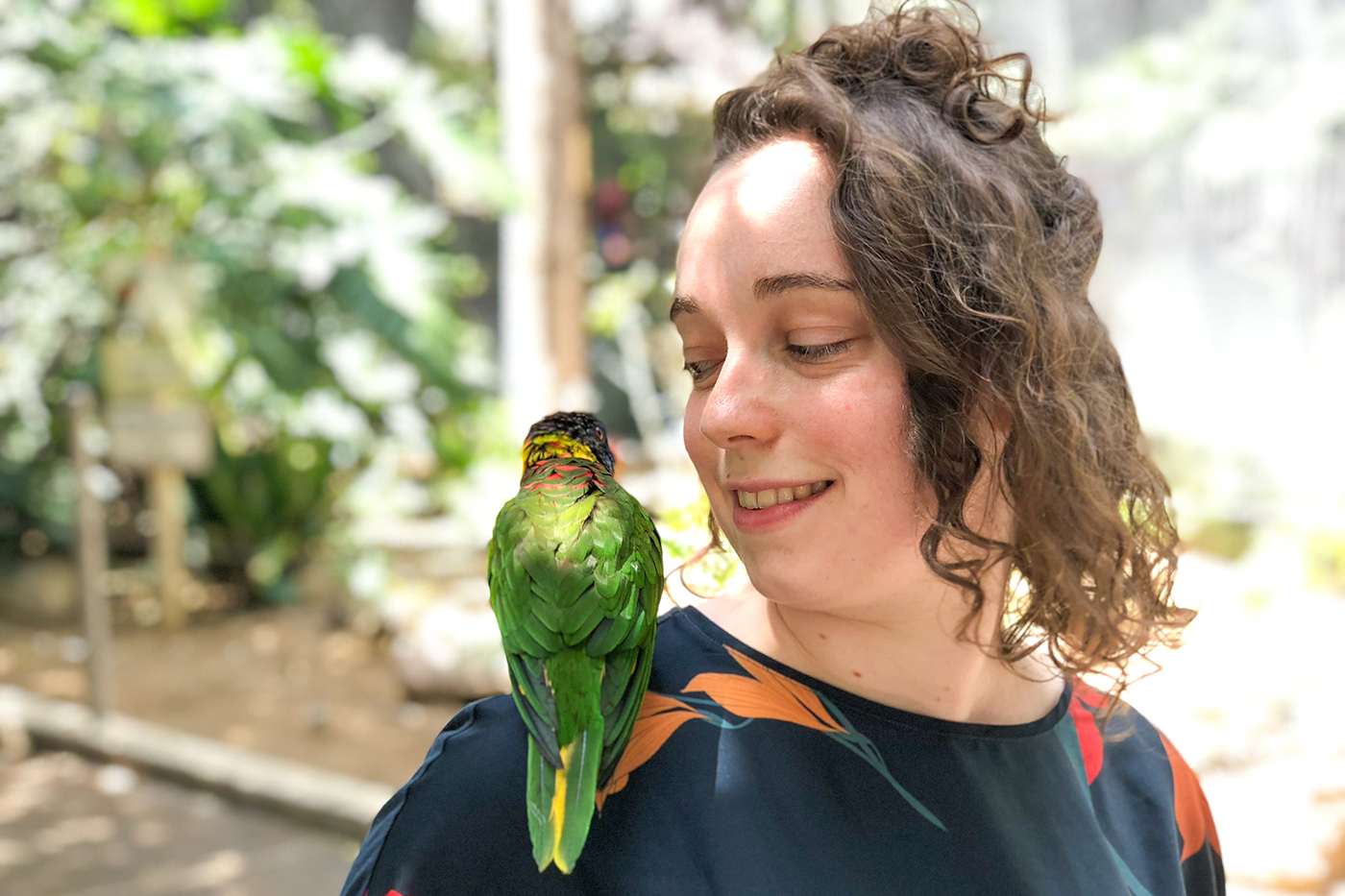
That would be Ellie, Cunha’s 11-year-old Goffin’s cockatoo and primary collaborator for the better part of a decade. A pink-tinged white parrot the size of a dove, Ellie can read basic words, draw 14 letters on a touchpad with her beak, and communicate a wide array of complex feelings and requests on her tablet. She can tell Cunha she’s hungry, and for what treats; when she’s feeling scared or happy; and when she wants to read a board book or listen to music.
During the conversation, Ellie taps a sequence of images on the screen to ask for a treat of sunflower seeds. When she gets them, she taps the on-screen buttons to make the tablet say “Yum” and “Happy,” in frenzied succession. Later, she requests “music,” then “piano” and “Beethoven.”
Cunha puts on a “classical solo piano” Pandora station. She once considered teaching the squirrels, too, to pick tunes, but decided against it. With Ellie and her two other cockatoos, Isabelle (a rescue with an amputated foot) and Tillie (a super-rare red-vented cockatoo, age 25), Cunha “already had too many opinions about music in the house,” she says.
On the surface, these displays can seem like mere fun diversions, straight out of David Letterman’s old late-night “Stupid Pet Tricks” segments—casting agents for “America’s Got Talent” have tried to get Cunha and Ellie on the show more than once. But Ellie’s “tricks” are the outgrowth of rigorous study and peer-reviewed findings. Furthermore, they’re at the forefront of an emerging body of research geared at leveraging technology to better understand and enrich the lives of animals in human care—from pet parrots and dogs to zoo animals and livestock.
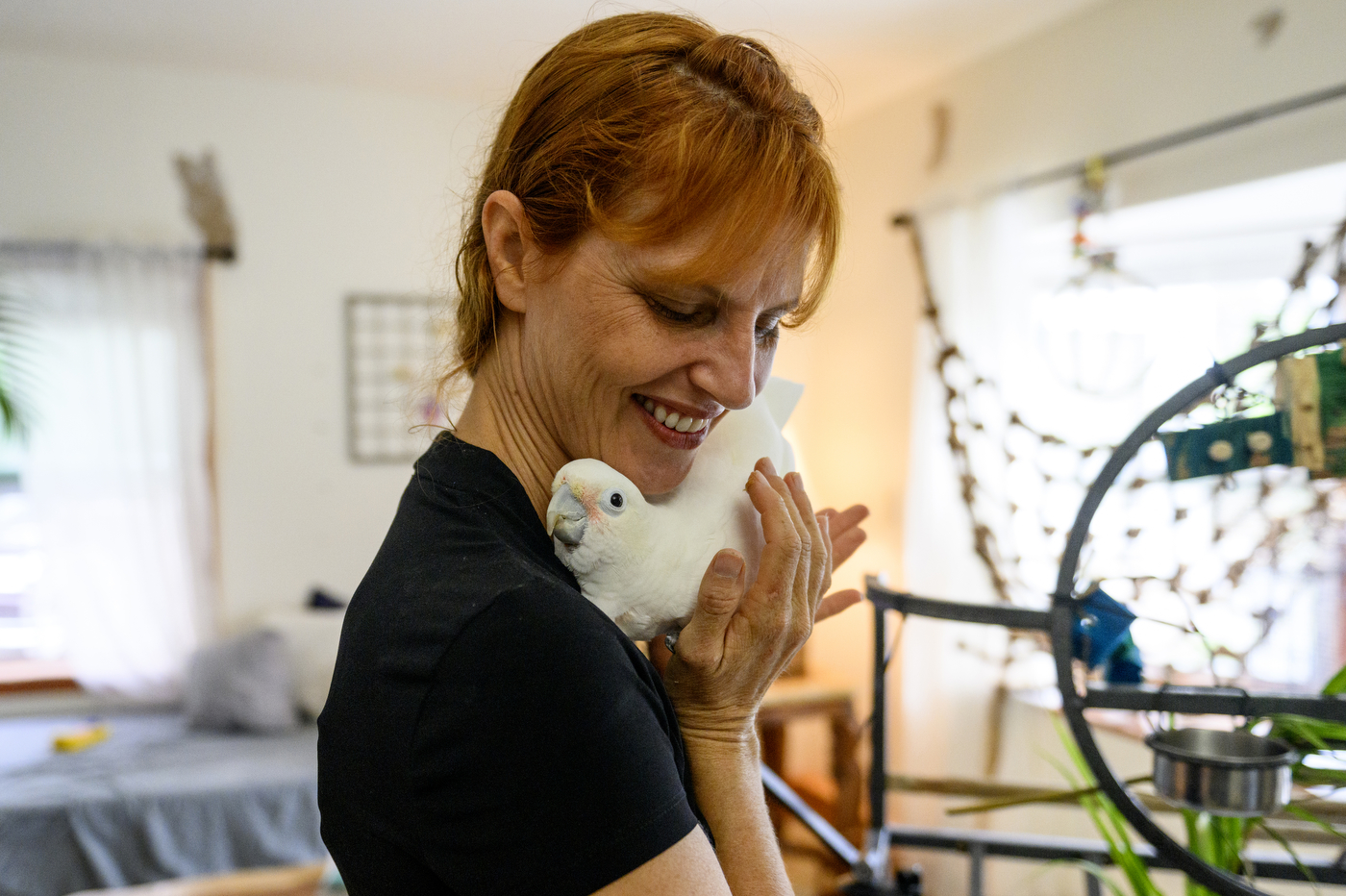
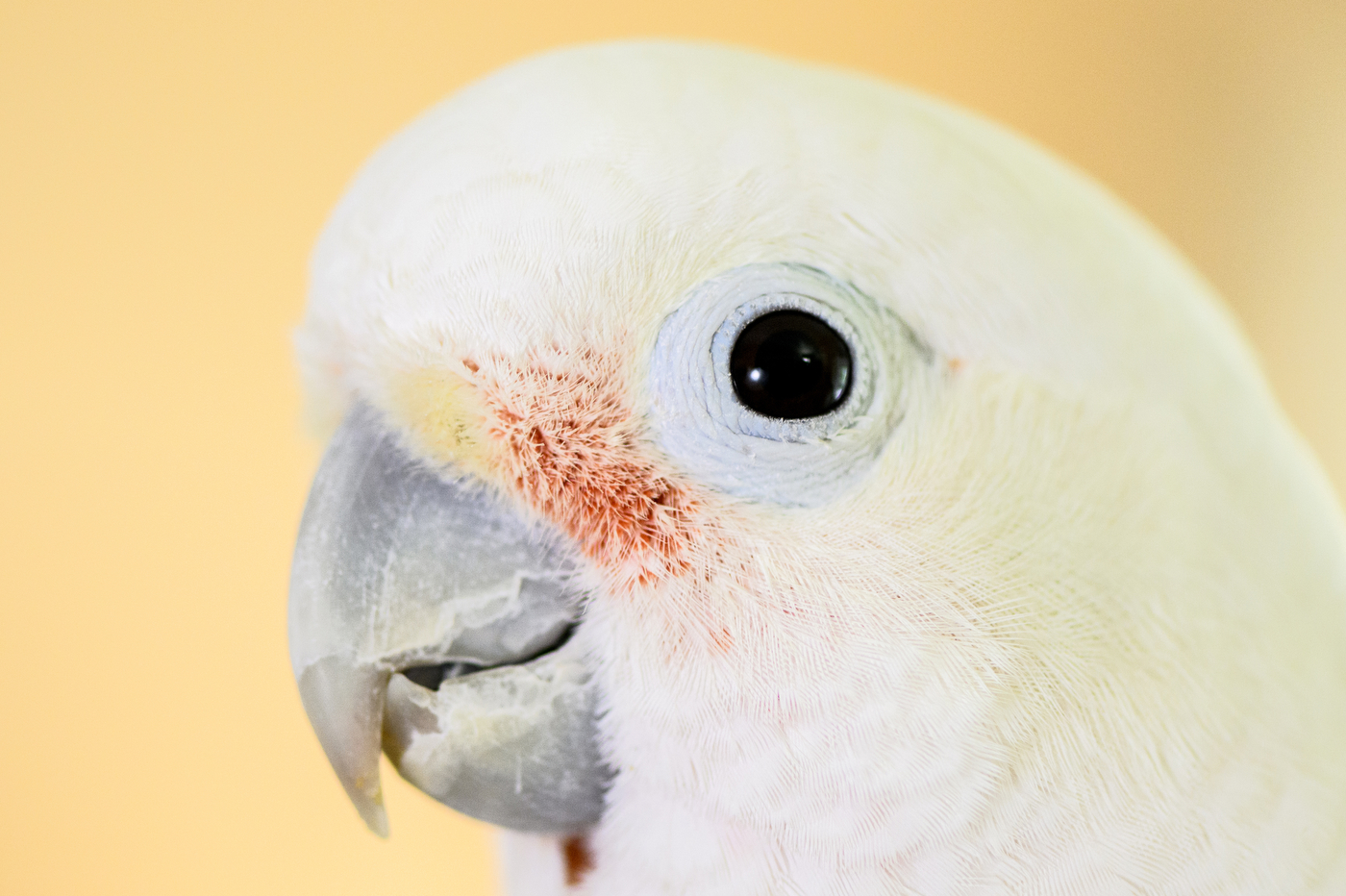
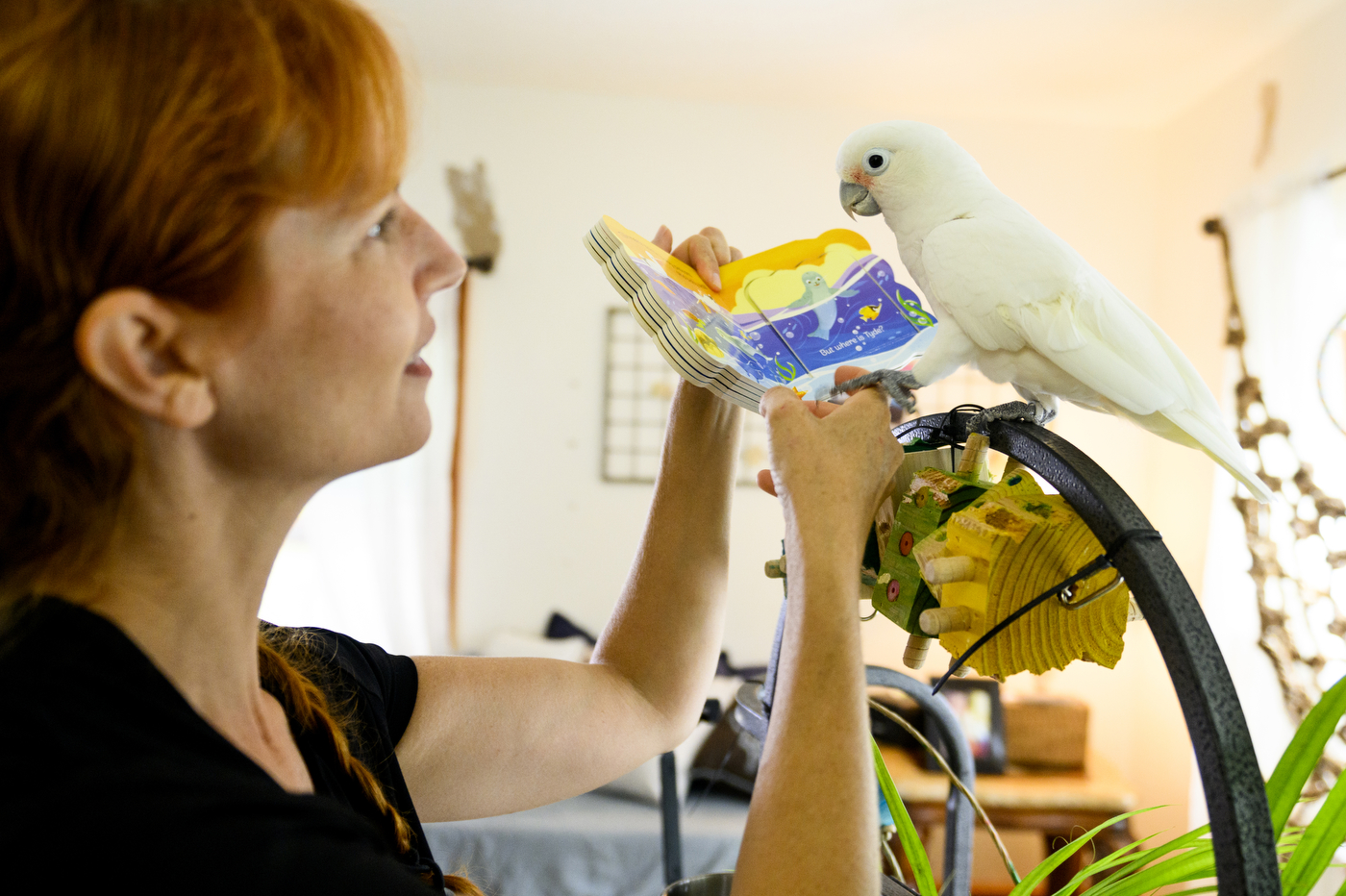
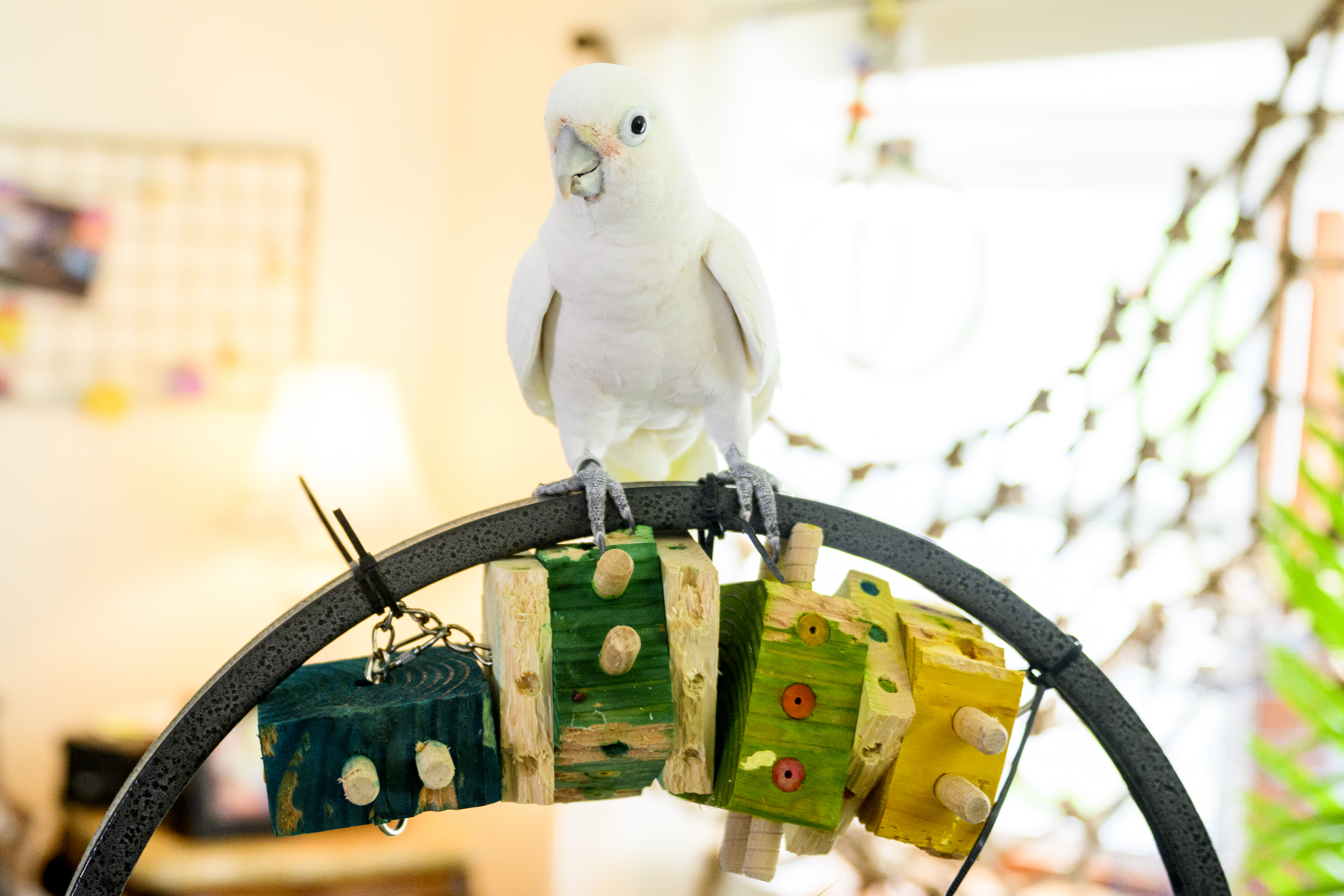
A property lawyer by training with no formal research background beyond a bachelor’s degree in behavioral neuroscience, Cunha signed on with Northeastern as a researcher last fall. The Northeastern affiliation came after years of forging an independent research career and collaborating with institutions including the University of Miami, Western Oregon University, MIT and the University of Glasgow.
“Northeastern is such an incredible university. Having the support is a total dream come true,” Cunha says.
Cunha is working with Rébecca Kleinberger, a Northeastern professor with a dual appointment in music and computer science, along with faculty at partner universities, to launch a lab at the Khoury College of Computer Science and the College of Arts, Media and Design (CAMD) dedicated to studying animals and technology—from prototyping new products to creating an ethical framework around the treatment of the animal subjects in such research. “Can we benefit animal lives, reduce boredom, and make sure we’re not just doing that for entertainment of humans?” Kleinberger asks, outlining the project’s fundamental goals. In addition to research, Kleinberger hopes that the lab’s offerings will include a class in Khoury on animal-computer interaction, as well as partnerships with organizations like Boston’s Franklin Park Zoo and the MSPCA.
Joining up with Northeastern gives Cunha, who will continue to work in Florida, the support she needs in furthering her university research with Kleinberger on parrot behavior and cognition—in the form of funding, library access and more—and lend the work she’s done thus far added credibility. It gives Northeastern expert insight into some of the most intelligent, confounding animals in captivity—ones with traits that, handled with care, make them uniquely suited to helping researchers unlock new revelations about what animals are capable of.
“A lot of the previous work on animals, specifically animal technology, has either been in terms of trying to test or demonstrate animal intelligence, trying to give animal puzzles and understanding how their minds work, trying to learn things for humans, or benefiting humans mainly in some way,” Kleinberger says. “From the beginning our focus with Jen has been to put the animal first — to really think about [whether] is there some true benefit.”
At the lab through Northeastern, she continues, “we are actively working on changing perception of what it means to care for an animal and what animals can do and the potential of technology for different species.”
Parrot Kindergarten
Cunha is 42, tall and tan, with a wide grin and a rope of bright red hair tied into a braid that reaches to her waist. She talks with her small flock of cockatoos in an encouraging singsong voice, like a teacher in an early childhood education classroom. That is, in effect, exactly what she is. As a complement to her research, Cunha runs Parrot Kindergarten, a paid online platform that offers video training modules for parrot owners. Her cockatoos occupy a room replete with the trappings of a preschool: board books, sensory toys, and even a visual schedule that signals to the birds, via brightly-colored Post-Its, when she will be away from the house. She does weekly coaching calls with owners and has about 200 paying clients, along with hundreds of thousands of followers on TikTok and Instagram.
The cornerstone of Parrot Kindergarten is the idea that challenging parrots intellectually can increase the bond between bird and owner, make the birds—who can live roughly as long as humans, depending on the breed—happier and healthier, and reduce their destructive activities. Such problems are rampant among parrots kept as pets. With prodigious intelligence and intense social needs, they get bored and stressed if left in a cage all day. This often leads to “stereotypies”—movement disorders that include self-harming behaviors like feather-picking. Bald parrots in certain breeds are a common sight.
“It’s a creature with the brain equivalent to a 6-to 8-year-old, but social and communications skills more like a 2-year-old,” says Irene Pepperberg, a scientist known for her groundbreaking studies on parrot cognition. “And they have a Swiss army knife glued to their face [in the form of a strong, dexterous beak]. They have a voice like a claxon, and they make total messes. That’s their nature.”
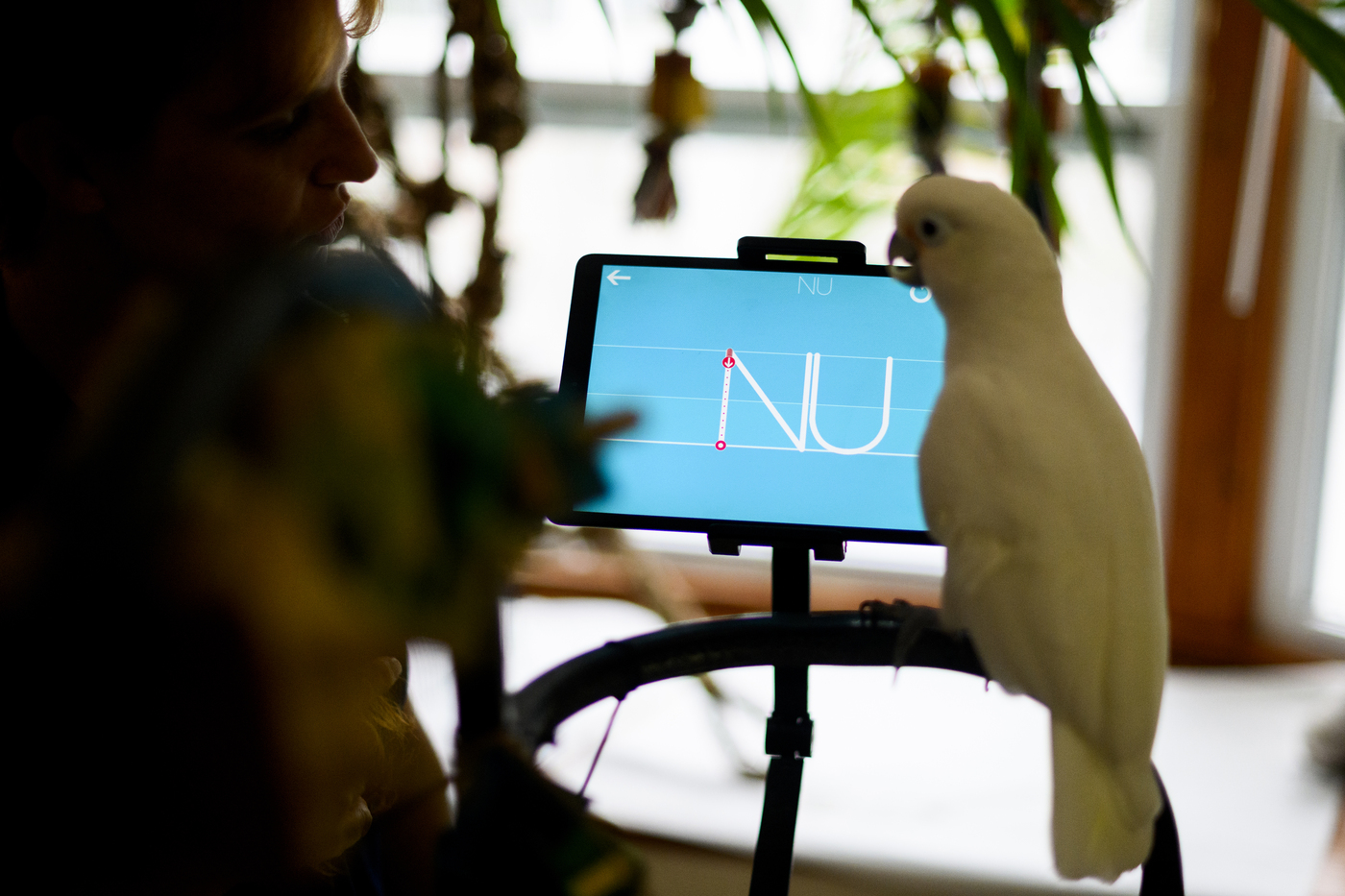
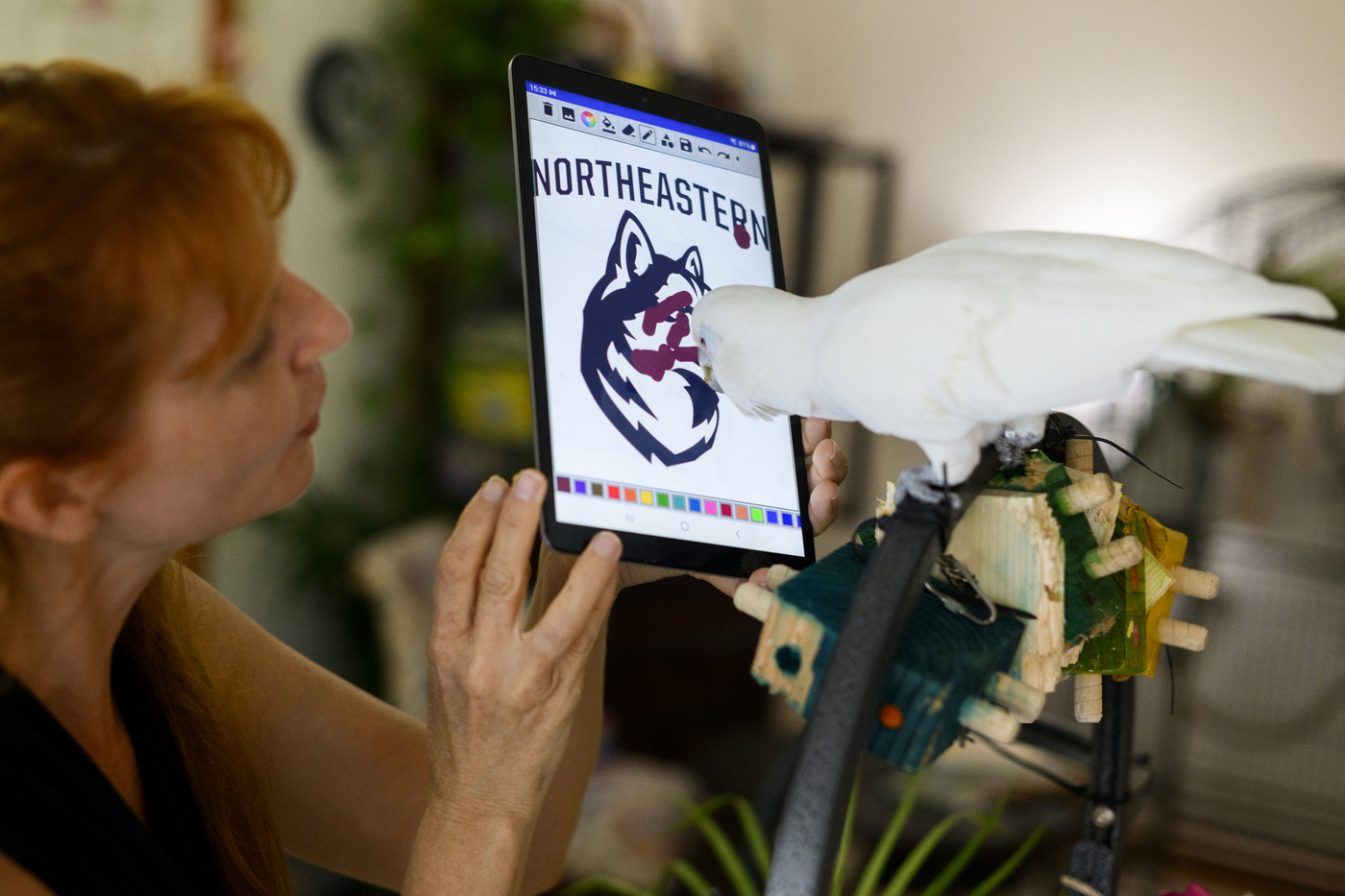
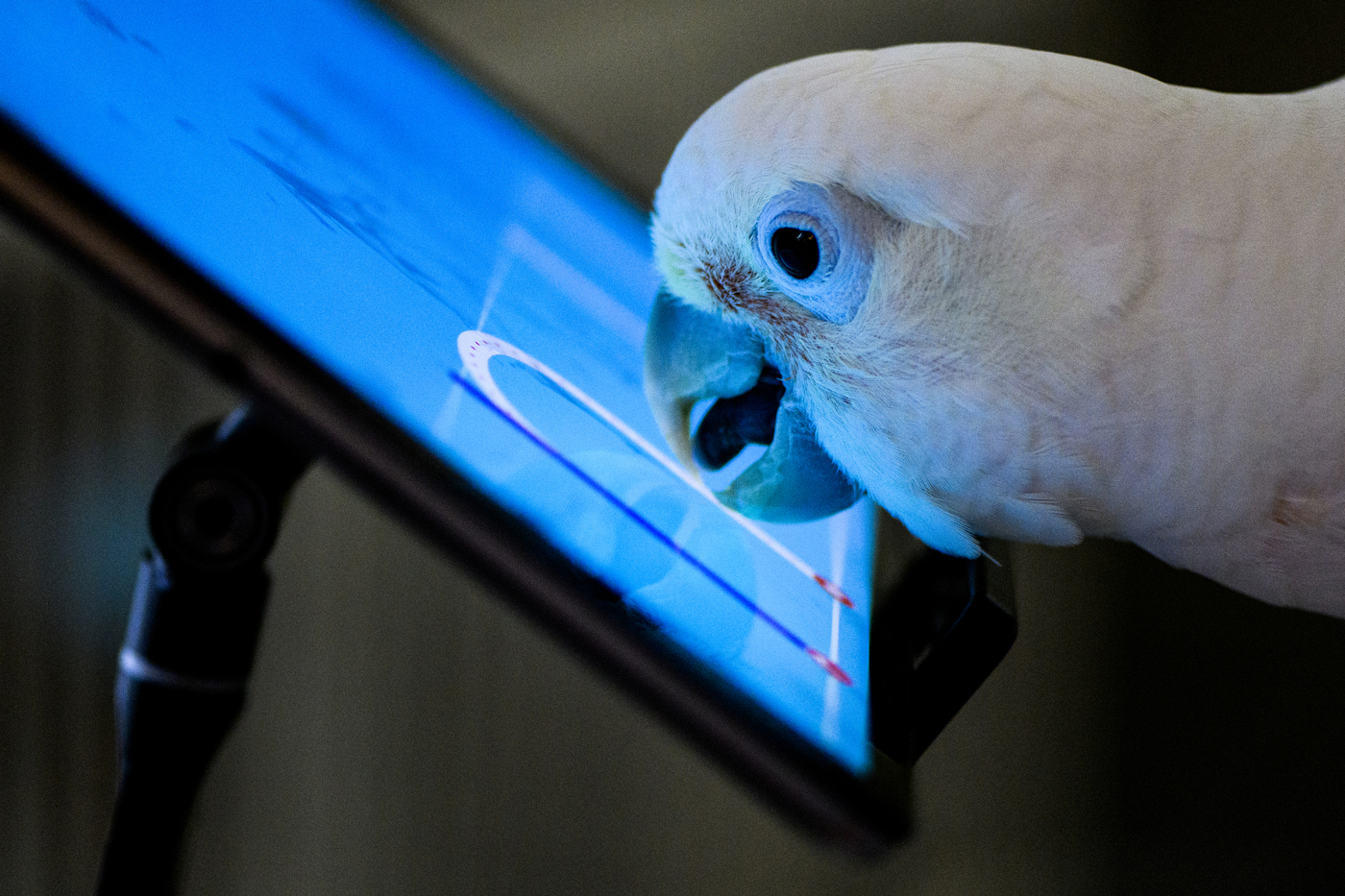
Desperation over Ellie’s behavior, in fact, kick-started Cunha’s research career. When Ellie, who was hatched by a breeder and raised with her parents in captivity, came to live with Cunha in 2012, “she was a very frustrated bird,” says Cunha. “She was just really smart, and the normal methods of enrichment weren’t enough. I did all the things you’re supposed to do. I had lots of foraging and toys and socialization. Even with all of that, she’d scream and throw things and have tantrums.”
Cunha started teaching Ellie tricks, but the bright little bird burned through them so quickly that she was soon back to frustration and boredom. “Then I thought, if I could teach her how to read…”
It seemed crazy. But Cunha knew that parrots were cognitively as capable as toddlers, and she had volunteer experience teaching reading to underprivileged schoolchildren. If Ellie could read, “there would be no ending to her learning,” Cunha thought, even if she lived the roughly 65 years expected for cockatoos.
So around 2016, they started with a pack of foam letters from Walmart. Before long, Ellie was making one-to-one associations between the letters and objects (“A” for apple, etc.), which progressed to spelling and blending sounds. “Oh my God, she’s doing it,” Cunha recalls thinking. Newly stimulated and eager to work, Ellie became happier and calmer. And Cunha sensed they were onto something bigger.
She reached out to Susan Clubb, a friend from the southeast Florida area’s parrot rescue community and widely-respected avian veterinarian and researcher who practiced nearby. Together they turned Ellie’s sessions into quantifiable data, and Cunha worked to replicate her results with other birds. In 2018, they presented findings at the Association of Avian Veterinarians’ national conference in Atlanta. Cunha collaborated with other academics from a range of disciplines, including early education and child psychology. Findings on parrots’ abilities to learn phonics, recognize and write upper- and lower-case letters, and use tablet communications boards—similar to what many autistic or otherwise nonverbal children use—followed.
After meeting at an online symposium during the height of COVID-19, Cunha began working with Kleinberger and Ilyena Hirskyj-Douglas, an animal-computer-interaction researcher at the University of Glasgow whose projects included developing a video calling system for her Labrador retriever, Zack. In April, the team presented research in which they showed a group of parrots (in conjunction with their human caregivers) how to video-call one another, then observed the parrots over three months. During the study, the birds made calls independently, formed bonds, and in some cases learned new behaviors from each other, including new vocalizations and flying.
Ellie, who participated in the pilot study, now makes regular calls to her favorite parrots and humans. During our visit, she dialed up Cookie, an African grey living in California, using her beak to tap an image of her friend on her tablet to request the call. Over the course of the short, chaotic session, the two birds squawked, preened, gave each other kisses, and wandered intermittently out of frame. It had a similar feel to when a 3-year-old FaceTimes her grandparents. Ellie is so well-versed in the calling system, Cunha says, that she will ring up Cunha’s mother—sometimes unsolicited. “Early on, I walked in the room and she was calling Rébecca,” Cunha says. “I told her, ‘Rébecca doesn’t know you yet. You shouldn’t be calling people.’”

There are some foreseeable drawbacks to this sort of autonomy. “Obviously there are privacy concerns,” says Hirskyj-Douglas: “if you are just out of the shower, naked, walking around, and then your bird decides now’s the time to make a video call.”
Still, with appropriate limits, Cunha can see a future where household birds could use such technology independently. “It would be pretty amazing for a bird to be able to go on and call someone who’s online right now,” Cunha says. “I think figuring out [how to] make that fit into families would be kind of a next step.”
Pets embrace technology
What Cunha and her collaborators are finding is even more remarkable considering how far the collective understanding of parrots has progressed over a few decades. Pepperberg started her research in the 1980s, when she bought a baby African grey from a pet store and named him Alex. At the time, even their basic dietary needs were a mystery. “They gave me a bag of sunflower seeds,” Pepperberg remembers. Nutritionally, the parrot world now likens this to giving a human a sackful of Big Macs as a sole food supply.
Very few veterinarians in the country would even see the birds, and those who did could provide little more than palliative care to sick parrots who were already beyond saving.
Through the late 1980s and 1990s, better comprehension of avian medical needs slowly grew, and national organizations cropped up to certify vets treating them. Alongside that, teaching parrot owners and veterinary students how to handle the birds became a priority. Because basic knowledge in a domestic setting was basically zero, the behavioral and medical study of parrots—from nutrition and basic anatomy to training—became almost inextricably bound within a small community of bird specialists across the United States.
Pepperberg laid the groundwork for that community’s understanding of parrot intellect. Alex, who died in 2007 at age 31, could recognize shapes and colors and had complex reasoning skills; when presented with a large green triangle and a small red triangle for example, he could tell you, one, what was different about them (color), and, two, which color key was bigger.
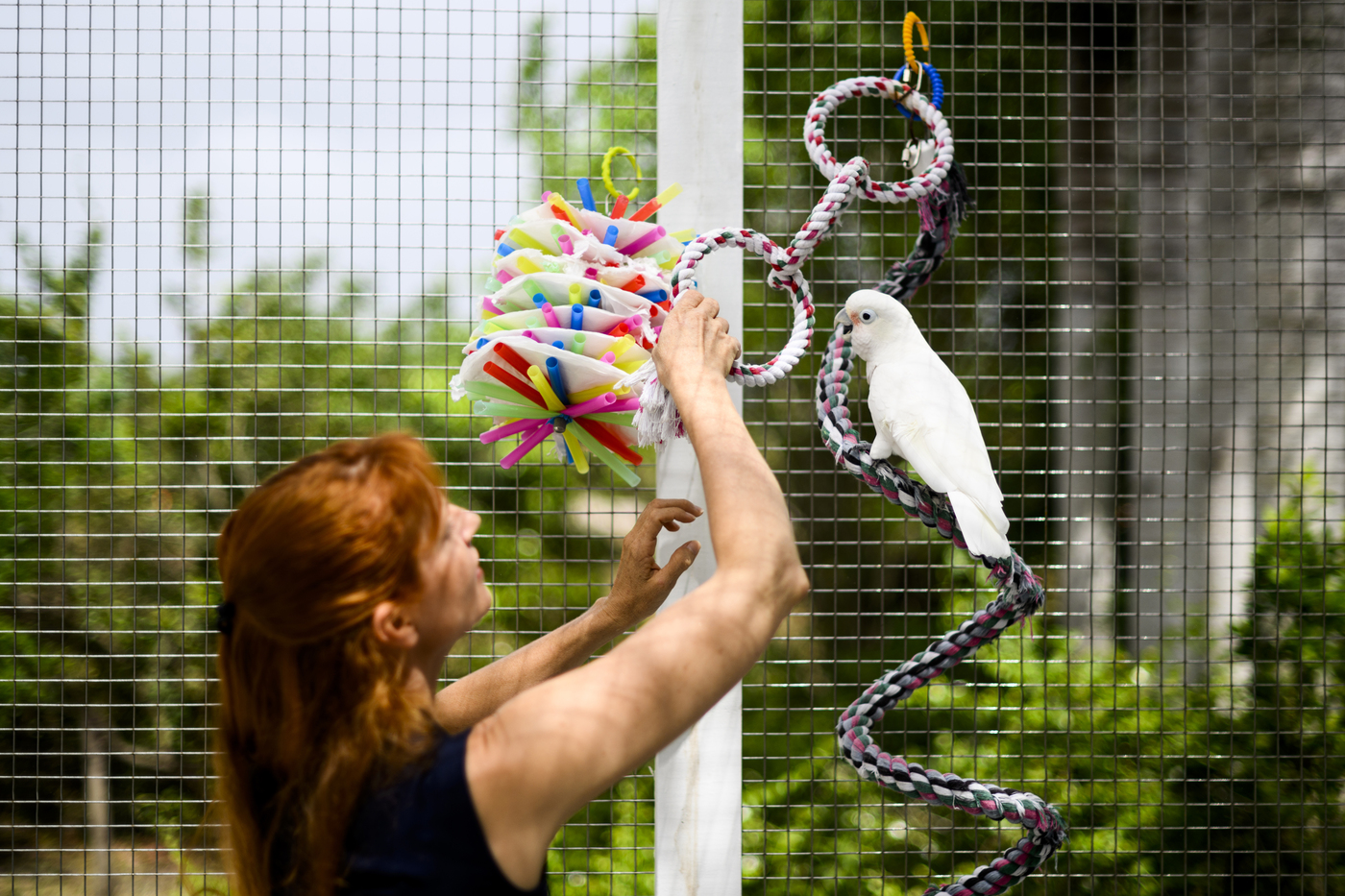
Advances in consumer technology have the potential to take the type of research Pepperberg and others do even further. Parrots can actually see what’s happening on modern screens, and as technology has advanced, the very real prospect of a parrot breaking a tablet has become less financially dire. “When I started, an LCD screen that we use all the time now was $3,000. Birds don’t see well on the old-fashioned CRT screens—their flicker fusion rate is much faster than ours,” Pepperberg says. Because new screens have faster frame speeds, parrots can see what’s on them as contiguous, rather than as a series of standalone stills.
This, combined with their intellect and ability to communicate, makes parrots ideal partners for exploring broader questions of animal-computer interaction. For Cunha, Kleinberger and others in the emerging “pet tech” field, a big one is the idea of consent—how to ensure that animal subjects are willing participants in both studies and in using future products and programs. During the video call study, for example, parrot subjects did not earn treats for making calls (to make sure they were choosing to call for their own reasons). Caretakers were instructed to end sessions at the first signs of stress.
How to limit parrot screen time is a relatively new concept in animal research—and it dovetails with questions about how humans interact with their devices.
“It’s important to give opportunities for them to not engage in the technology,” Hirskyj-Douglas says.
Birds lead the way
To do that, Cunha offers up lots of choices during sessions, then lets the birds lead the way. “What can we learn from those playful interactions?” she asks. “From almost un-labbing the animals and still looking at the science in a really rigorous way?”
Screens, she’s found, can be useful in socializing and challenging the parrots she works with, both at home and on coaching calls. She’s used video calling as a method for her own birds to get comfortable with one another from a distance, to reduce the risk of them hurting each other when they’re together in person.
In her counseling sessions, Cunha often recommends reading and writing for the most stubborn, headstrong birds. “We have a little guy right now that is really angry. The caregiver can’t reach him,” she says. And I was like, ‘I think you just need to start teaching in phonics.’ Because it becomes a journey between the two of them; it’s like this joint adventure.”
With Ellie and the flock, lessons have progressed to specific topics. “We’re always looking at new vocabulary,” she says. “They learn about Santa and Frosty and the Easter Bunny. We incorporate cultural themes—this is what Santa is, and Santa brings presents; this is a snowman. They need to stay mentally stimulated, or else we have behavior problems.”
As if to underscore the point, Ellie sits nearby, rummaging through a purse without permission. She’s just finished a round of writing, scrawling a lower-case “n” in bright green on a drawing app. Across the room, Tillie sends a full bowl of water clattering to the ground, eager to be involved in the conversation.
By figuring out what the animals really want and enjoy, Kleinberger’s lab at Northeastern can work on enriching their environments by giving them control. One of Kleinberger’s designs, for instance, is an artificial wooden perch with a switch that allows Sammy, a hyacinth macaw at the San Diego Zoo, to turn on music in his enclosure.
Cunha’s birds, too, have a lot of say in their environment. Cunha says Ellie will let her know, via her communications board, when the air conditioner is set too cold. The doors and windows stay flung open in the gentle Florida warmth, and the birds can request time in an outdoor flight cage.
Cunha still practices law part-time, but, after years of moonlighting, she now has the financial freedom to spend most of her time on Parrot Kindergarten and her work with Kleinberger’s lab at Northeastern. What she and her collaborators have learned, she thinks, can enrich the lives of a surprising array of creatures. Parrot Kindergarten runs interspecies workshops to see what other animals might make of a tablet.
“We already see most of the animals interacting with it,” Cunha says. “The ducks are playing Balloon Pop. Dogs have a communication board with up to 20 words. The squirrels have theirs.”
“Even a fish can learn; everything can learn,” she adds. “I think we underestimate what animals can do all the time.”
Schuyler Velasco is a Northeastern Global News Magazine reporter. Email her at s.velasco@northeastern.edu. Follow her on Twitter @Schuyler_V





